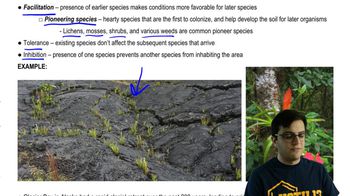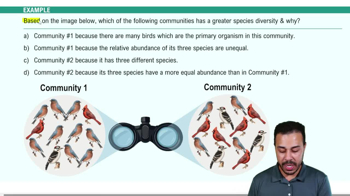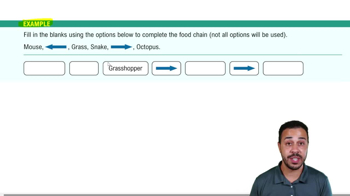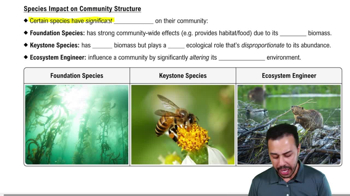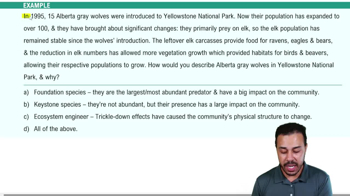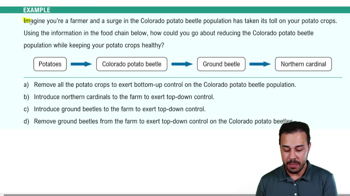Table of contents
- 1. Introduction to Biology2h 42m
- 2. Chemistry3h 40m
- 3. Water1h 26m
- 4. Biomolecules2h 23m
- 5. Cell Components2h 26m
- 6. The Membrane2h 31m
- 7. Energy and Metabolism2h 0m
- 8. Respiration2h 40m
- 9. Photosynthesis2h 49m
- 10. Cell Signaling59m
- 11. Cell Division2h 47m
- 12. Meiosis2h 0m
- 13. Mendelian Genetics4h 44m
- Introduction to Mendel's Experiments7m
- Genotype vs. Phenotype17m
- Punnett Squares13m
- Mendel's Experiments26m
- Mendel's Laws18m
- Monohybrid Crosses19m
- Test Crosses14m
- Dihybrid Crosses20m
- Punnett Square Probability26m
- Incomplete Dominance vs. Codominance20m
- Epistasis7m
- Non-Mendelian Genetics12m
- Pedigrees6m
- Autosomal Inheritance21m
- Sex-Linked Inheritance43m
- X-Inactivation9m
- 14. DNA Synthesis2h 27m
- 15. Gene Expression3h 20m
- 16. Regulation of Expression3h 31m
- Introduction to Regulation of Gene Expression13m
- Prokaryotic Gene Regulation via Operons27m
- The Lac Operon21m
- Glucose's Impact on Lac Operon25m
- The Trp Operon20m
- Review of the Lac Operon & Trp Operon11m
- Introduction to Eukaryotic Gene Regulation9m
- Eukaryotic Chromatin Modifications16m
- Eukaryotic Transcriptional Control22m
- Eukaryotic Post-Transcriptional Regulation28m
- Eukaryotic Post-Translational Regulation13m
- 17. Viruses37m
- 18. Biotechnology2h 58m
- 19. Genomics17m
- 20. Development1h 5m
- 21. Evolution3h 1m
- 22. Evolution of Populations3h 52m
- 23. Speciation1h 37m
- 24. History of Life on Earth2h 6m
- 25. Phylogeny2h 31m
- 26. Prokaryotes4h 59m
- 27. Protists1h 12m
- 28. Plants1h 22m
- 29. Fungi36m
- 30. Overview of Animals34m
- 31. Invertebrates1h 2m
- 32. Vertebrates50m
- 33. Plant Anatomy1h 3m
- 34. Vascular Plant Transport1h 2m
- 35. Soil37m
- 36. Plant Reproduction47m
- 37. Plant Sensation and Response1h 9m
- 38. Animal Form and Function1h 19m
- 39. Digestive System1h 10m
- 40. Circulatory System1h 57m
- 41. Immune System1h 12m
- 42. Osmoregulation and Excretion50m
- 43. Endocrine System1h 4m
- 44. Animal Reproduction1h 2m
- 45. Nervous System1h 55m
- 46. Sensory Systems46m
- 47. Muscle Systems23m
- 48. Ecology3h 11m
- Introduction to Ecology20m
- Biogeography14m
- Earth's Climate Patterns50m
- Introduction to Terrestrial Biomes10m
- Terrestrial Biomes: Near Equator13m
- Terrestrial Biomes: Temperate Regions10m
- Terrestrial Biomes: Northern Regions15m
- Introduction to Aquatic Biomes27m
- Freshwater Aquatic Biomes14m
- Marine Aquatic Biomes13m
- 49. Animal Behavior28m
- 50. Population Ecology3h 41m
- Introduction to Population Ecology28m
- Population Sampling Methods23m
- Life History12m
- Population Demography17m
- Factors Limiting Population Growth14m
- Introduction to Population Growth Models22m
- Linear Population Growth6m
- Exponential Population Growth29m
- Logistic Population Growth32m
- r/K Selection10m
- The Human Population22m
- 51. Community Ecology2h 46m
- Introduction to Community Ecology2m
- Introduction to Community Interactions9m
- Community Interactions: Competition (-/-)38m
- Community Interactions: Exploitation (+/-)23m
- Community Interactions: Mutualism (+/+) & Commensalism (+/0)9m
- Community Structure35m
- Community Dynamics26m
- Geographic Impact on Communities21m
- 52. Ecosystems2h 36m
- 53. Conservation Biology24m
51. Community Ecology
Community Structure
Problem 11`
Textbook Question
There are fewer lions in Africa's Serengeti than there are zebras. This is principally because
a. Zebras tend to drive off lions
b. Lions compete directly with cheetahs, whereas zebras do not have any competitors
c. Zebras have mutualists that increase their population, whereas lions do not
d. There is less energy available in zebras to support the lion population than there is in grass to support the zebras
e. Zebras are a keystone species, whereas lions are not
 Verified step by step guidance
Verified step by step guidance1
Step 1: Understand the concept of energy transfer in ecosystems. Energy flows through trophic levels, starting from primary producers (like grass) to primary consumers (like zebras) and then to secondary consumers (like lions). At each level, energy is lost due to metabolic processes, making less energy available for higher trophic levels.
Step 2: Analyze the relationship between lions and zebras. Lions are predators that rely on zebras as a food source. Zebras, on the other hand, consume grass, which is abundant and serves as a primary energy source.
Step 3: Consider the principle of energy availability. Since energy diminishes as it moves up trophic levels, there is less energy available to support the lion population compared to the energy available to support the zebra population.
Step 4: Evaluate the other answer choices. For example, zebras do not drive off lions (a), lions and cheetahs do not compete directly for zebras (b), and zebras are not considered mutualists with other species that increase their population (c). Additionally, zebras are not classified as keystone species (e).
Step 5: Conclude that the correct answer is related to energy availability. The principle reason for fewer lions than zebras is that there is less energy available in zebras to support the lion population than there is in grass to support the zebras.
 Verified video answer for a similar problem:
Verified video answer for a similar problem:This video solution was recommended by our tutors as helpful for the problem above
Video duration:
1mPlay a video:
Was this helpful?
Key Concepts
Here are the essential concepts you must grasp in order to answer the question correctly.
Trophic Levels and Energy Transfer
In an ecosystem, energy flows from producers to various levels of consumers. Lions, as apex predators, occupy a higher trophic level than zebras, which are herbivores. The energy available to support a population decreases at each trophic level due to energy loss through metabolic processes. This concept explains why fewer lions can be supported compared to zebras, as there is less energy available to sustain higher-level consumers.
Recommended video:
Guided course
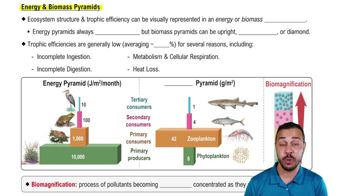
Energy & Biomass Pyramids
Keystone Species
A keystone species is one that has a disproportionately large impact on its environment relative to its abundance. Zebras can be considered a keystone species because their grazing habits help maintain the grassland ecosystem, promoting biodiversity. In contrast, while lions are important for controlling prey populations, they do not have the same level of ecological influence as zebras, which can affect the structure of the entire ecosystem.
Recommended video:

Biological Species Concept
Competition and Mutualism
Competition occurs when species vie for the same resources, which can limit population sizes. In this context, lions compete with other predators like cheetahs for food, while zebras may benefit from mutualistic relationships with other species, such as birds that eat parasites off their bodies. These interactions can enhance zebra populations, while lions face more direct competition, contributing to their lower numbers in comparison.
Recommended video:
Guided course
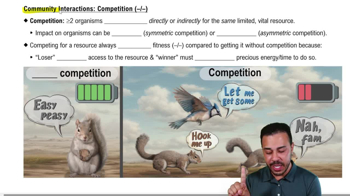
Community Interactions: Competition (-/-)
Related Videos
Related Practice








